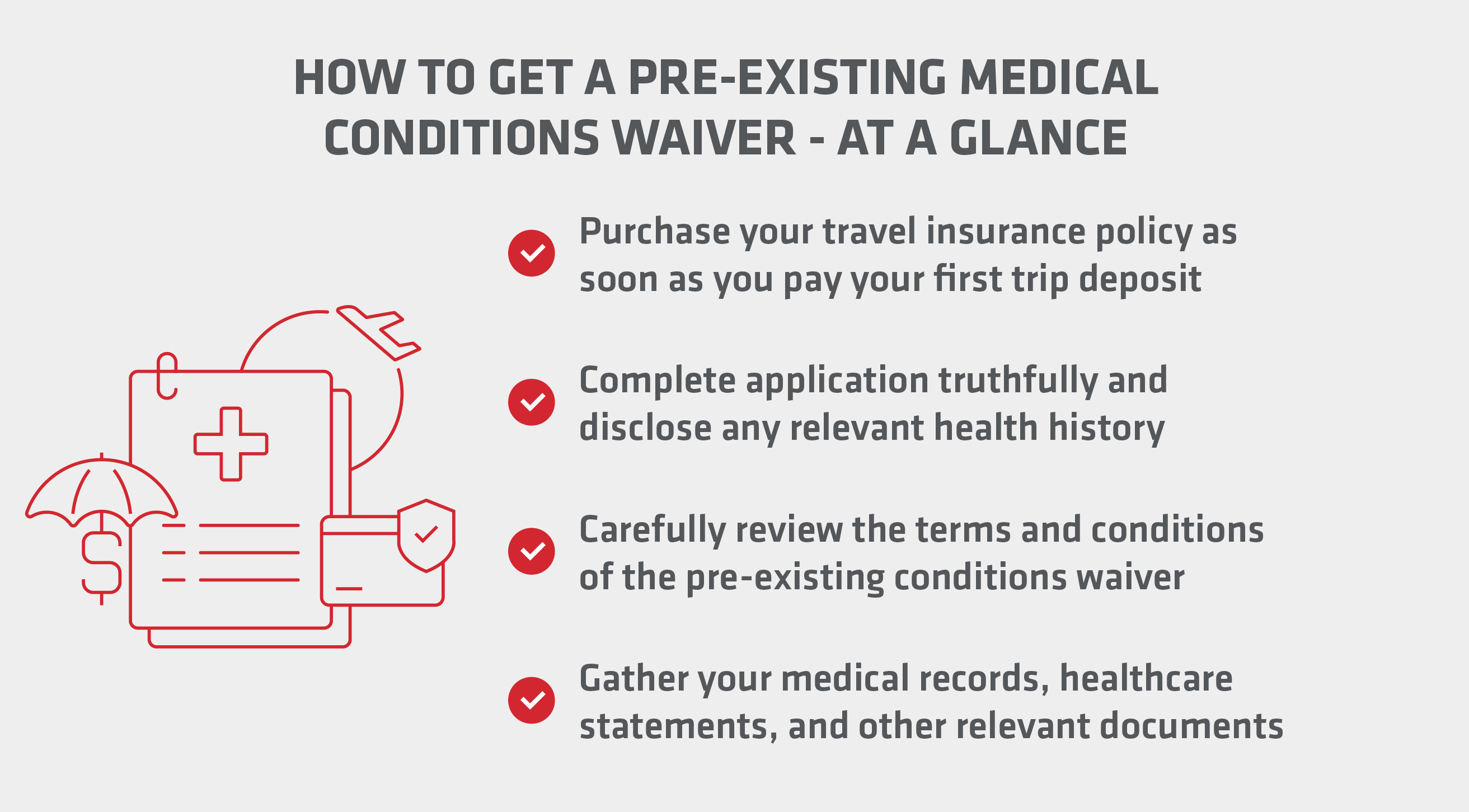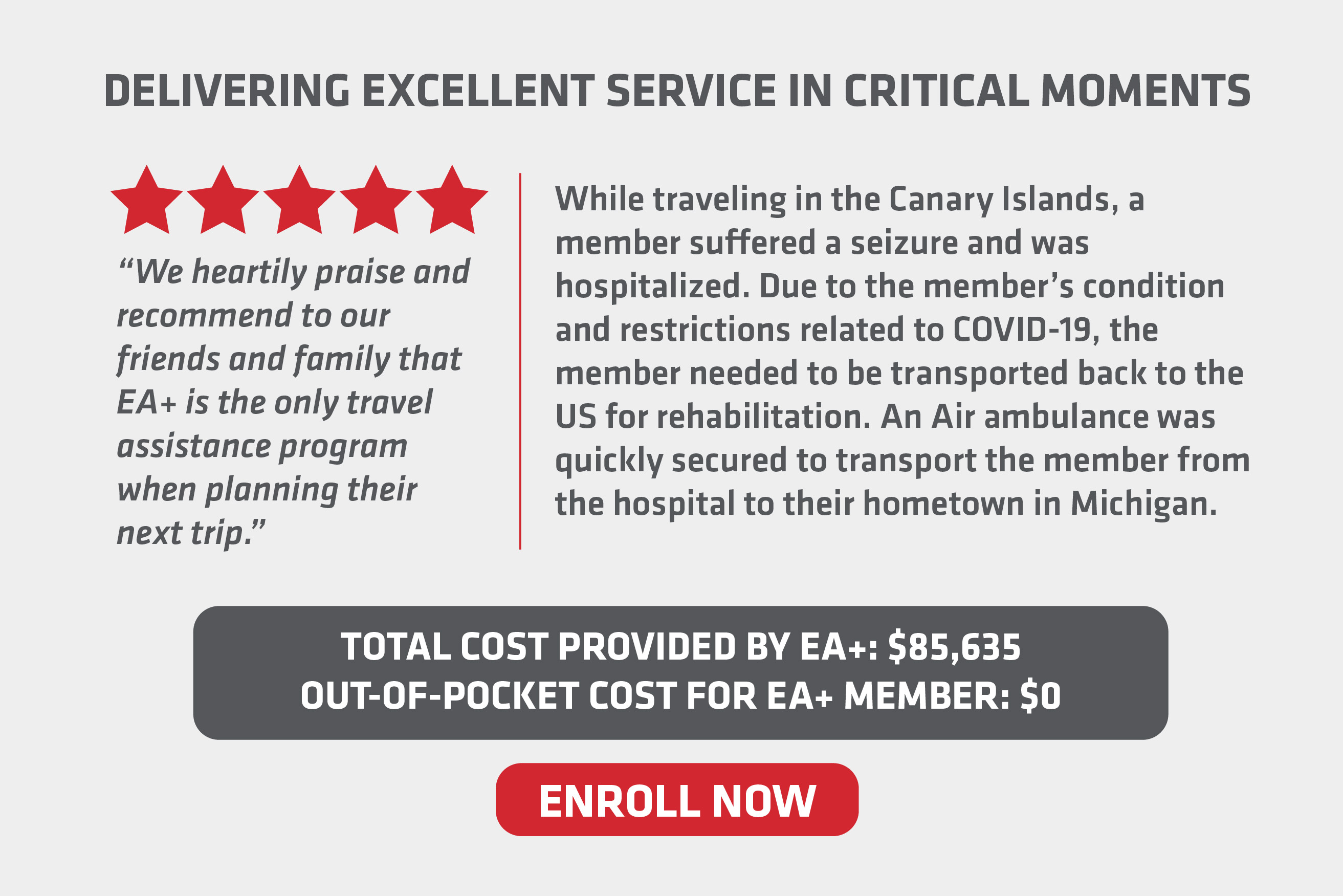Don’t let a pre-existing condition affect your ability to protect yourself on your next trip.
Published on March 14th, 2024 in Travel Insurance
More Americans are buying travel protection than ever.
In 2022, the U.S. Travel Insurance Association conducted the Travel Protection Market Study and found several interesting facts on the topic:
There’s a good reason for this. Both travel assistance and travel insurance can provide numerous benefits to all types of travelers.
We learned from the COVID pandemic that medical emergencies while traveling don’t discriminate based on age or previous health risks. More travelers than ever now value the additional protection that these types of protection and membership plans provide. It brings peace of mind knowing you have protection if you have to cancel your trip due to unplanned illness, or if your trip is interrupted by a sudden medical emergency.
We’ve already covered the benefits of travel insurance, but as a quick recap, it’s designed to reimburse you for trip cancellation, trip interruption, cover medical expenses, and other unanticipated trip costs you may incur while traveling.
But today we’re going to zoom in on a specific type of traveler: Those with pre-existing conditions.
This type of traveler may wonder:
In this article, we’re going to answer all of the above questions, give tips on purchasing travel insurance, plus a whole lot more. Let’s go!
What are considered pre-existing conditions?
The term “pre-existing condition” can be confusing for travelers and may result in unsuccessful insurance claims. Pre-existing conditions in the context of travel insurance generally refer to documented medical conditions that you have been diagnosed with or received treatment for before purchasing the insurance policy. These conditions can vary, but common examples include:
In broad terms, most travel insurance companies usually define a pre-existing condition as a diagnosed illness or medical issue that hasn’t remained stable over a specified look-back period. “Stable” implies no changes or deterioration in the condition—no new diagnoses, treatments, medications, or pending/in-progress treatments, scans, or test results.
Can you buy travel insurance if you have a pre-existing condition?
Absolutely. Comprehensive travel insurance plans from reputable companies come with emergency medical coverage. This coverage can complement or substitute your regular health insurance, assisting in reimbursing emergency medical expenses incurred during your travels.
Many comprehensive travel insurance plans extend coverage to include pre-existing medical conditions, sometimes at no extra cost. However, if you end up trying to use this travel insurance coverage to pay for medical bills incurred on your trip related to one of your pre-existing conditions, you may run into trouble if you haven’t secured a “pre-existing medical conditions waiver.”
What is a pre-existing medical conditions waiver?
A pre-existing medical conditions waiver is an allowance or endorsement within a travel insurance policy that provides coverage for medical conditions that you (or a family member) may have before purchasing the insurance. Typically, travel insurance policies exclude medical coverage for pre-existing conditions, considering them as elevated risks. However, by obtaining a pre-existing medical conditions waiver, you essentially gain approval for coverage related to these pre-existing health issues.
How do you obtain a pre-existing medical conditions waiver?
To qualify for this waiver, you must meet certain conditions. Keep in mind that eligibility criteria may vary among insurance providers. Here are a few general steps that you will likely need to take to obtain this waiver:
You (or your family member) will need to be medically capable for traveling in order to qualify. You’ll also need to insure your entire trip (not just the flight, for example) in order to qualify for a waiver.

These steps are crucial to obtaining a pre-existing medical conditions waiver, because if you purchase a policy without one, insurance companies may look to deny your medical claim for reimbursement based on what’s called a “look-back period.”
What is a look-back period?
A look-back period is a specified timeframe that insurance companies examine to assess the stability of your health condition. This period is crucial in determining whether a particular medical condition qualifies as pre-existing. This is what an insurance company will use to assess your claim for medical bills if you do not have a pre-existing medical conditions waiver.
During the look-back period, the insurance provider reviews your recent medical history to check for any changes or developments in your health. The purpose is to identify any new official diagnoses, medical treatment, medications, or alterations in your condition. If your health remains stable within this defined period, it is less likely to be classified as a pre-existing condition. The length of the look-back period can vary between insurance companies and policies. Commonly, it ranges from a few months to a couple of years.
Will travel insurance be more expensive if you have pre-existing medical conditions?
Yes, travel insurance premiums can be higher if you have a pre-existing medical condition. Travel insurance companies assess the risk of covering individuals with pre-existing conditions (among other factors) and as a result, they may charge higher premiums to account for potential medical expenses or trip cancellations related to those conditions. Some policies may actually exclude coverage for pre-existing conditions altogether — so be sure to read the fine print carefully.
Finding travel insurance coverage for pre-existing medical conditions
Now that you know the lay of the land, here are some tips for finding travel insurance that will cover your pre-existing medical condition.
Get quotes from reputable insurance companies
We know it’s a bit anticlimactic, but the simplest and most reasonable solution is to just purchase comprehensive plans from reputable travel insurance companies with full disclosure about your medical condition. Two great options are:
Note: Comprehensive plans are much different than so-called “flight insurance plans” you buy from the airline. These will definitely not have any medical coverage, much less coverage for pre-existing conditions.
For Emergency Assistance Plus members, TripInsure Plus is a great option because it acts as the perfect complement to your travel assistance protection. Get full protection with maximum financial efficiency. Get a free quote from TripInsure Plus.

We recommend getting quotes from multiple travel insurance companies so you can compare coverages and costs.
For serious conditions, try specialist medical sites
For comprehensive medical coverage of more severe conditions like heart ailments, specific joint issues, or cancer, you may need to explore specialized medical insurers, which are often not featured on regular comparison websites. An example of one of these options is Allianz Global Assistance.
Note: The TripInsure Plus Premium plan also includes a pre-existing condition exclusion, as well as optional Cancel for Any Reason** coverage.
**Additional terms and conditions apply. Optional CFAR comes at an additional cost and is not available to residents of NY.
Complement your travel insurance policy with a travel assistance membership
It’s crucial to understand a fundamental aspect of all types of insurance, be it health or travel:
Travel insurance primarily operates by reimbursing you after a situation has been resolved, offering limited proactive assistance during emergencies.
In contrast, a travel assistance membership plays a proactive role in aiding you during a medical emergency while on a trip. This assistance begins with a single phone call and services are arranged and provided on your behalf. Unlike traditional health or travel insurance companies, numerous travel assistance providers have response centers ready to take your call whenever you require assistance no matter where in the world you are.
For instance, Emergency Assistance Plus® (EA+®) operates 24/7/365, ensuring that you can make a call and arrange travel assistance services. Common services facilitated by such providers include:
And these are only a few of the protections EA+ offers our members—you can read more details on our plan information page.
To speak with an expert about the benefits of a travel assistance membership, contact us via our website or call: 1-866-863-4460.


Should a medical emergency derail your travel, Emergency Assistance Plus® (EA+®) has you protected no matter where you are.
Learn MoreRelated resources

Travel Insurance
Everyone knows baggage insurance provides coverage for lost, stolen or delayed luggage—here’s everything else you need to know.
Continue Reading
Travel Insurance
A look into travel insurance coverage types, different scenarios where you might want to buy, and tips for making sure your flight is protected.
Continue ReadingIf a medical emergency occurs while you’re traveling—either domestically or abroad—you want to know that you and your loved ones are well-protected. Emergency Assistance Plus not only offers that protection but the peace of mind to explore the world with confidence.
